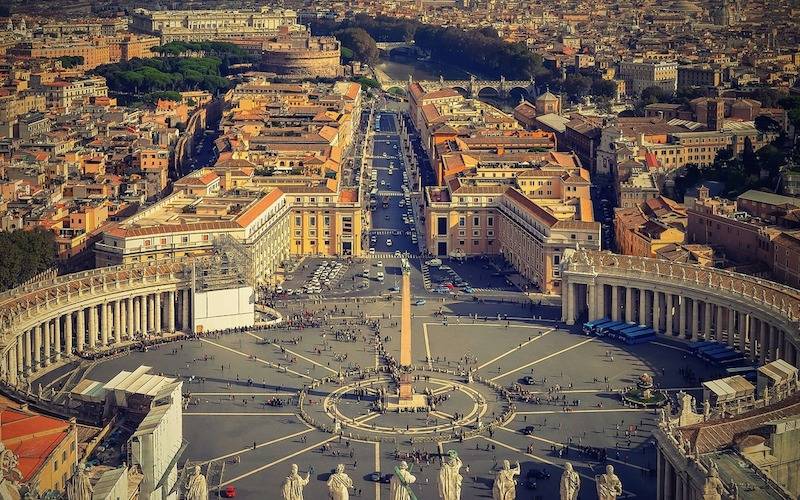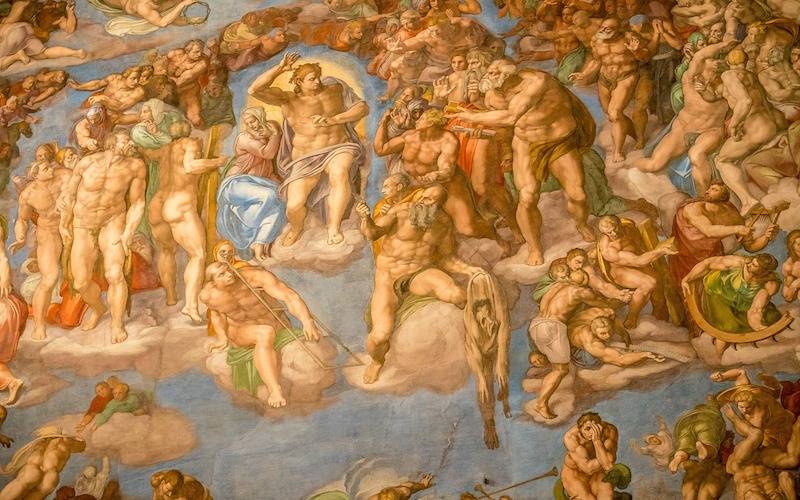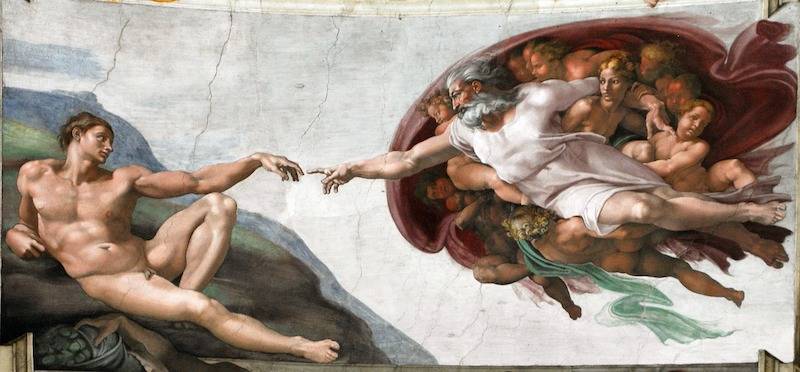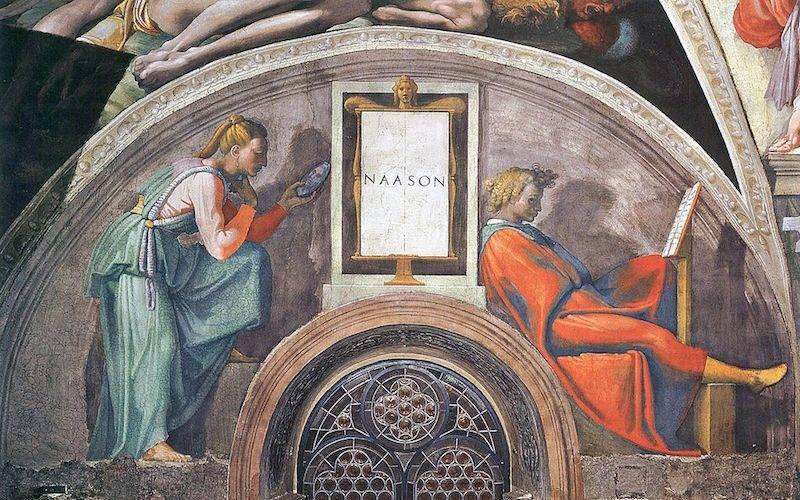Today’s post is a guest blog on the Sistine Chapel Rome by Marilyn Nash on behalf of holyart.com.
When I stepped into the Sistine Chapel, my immediate wish was that everyone else would leave so that I could be there alone. I wanted to become one with its magnificence; a breathtaking trinity of spirituality, art, and history. I am Roman Catholic but I promise that whatever your faith, you will feel the same.

A Little Background to the Sistine Chapel
Known Primarily for Michelangelo’s Renaissance Frescos, the art of the Sistine Chapel also includes works by other Renaissance masters such as Perugino, Pinturicchio, Sandro Botticelli, Ghirlandaio, Cosimo Rosselli, Benedetto, Luca Signorelli, and Bartolomeo della Gatta.
The Sistine Chapel was built by the architect Giovanni dei Dolci under commission of Sixtus IV. It is impossible for one’s eyes and soul to take in all this beauty in one visit.
Although not a well-known fact, at first, Michelangelo wanted nothing to do with the Sistine Chapel. He was a master sculptor whose passion was devoting his time and energy to sculpting. In fact, he considered himself a sculptor who painted rather than a painter who sculpted. But he half-heartedly accepted the assignment and worked on the ceiling from 1508 to 1512.

An Interesting Theory
There is a theory that in the section of the Sistine’s ceiling, entitled, “The Creation of Adam,” there exists an outline of the human brain. Theorists believe that Michelangelo’s intent was to call to mind God’s gift of intelligence to His first human creation.
The Wall Frescoes
Although the ceiling is the most well-known aspect of the chapel, the walls are of equal beauty and importance.
The North wall is the canvas for six frescoes which represent events from the life of Jesus. These were painted by Perugino, Pinturicchio, Sandro Botticelli, Domenico Ghirlandaio, and Cosimo Rosselli.
The south wall is the canvas which represents the life of Moses. These images were painted by Perugino, Pinturicchio, Botticelli, Domenico and Benedetto Ghirlandaio, Rosselli, Luca Signorelli, and Bartolomeo della Gatta.
Between the windows, smaller paintings represent various popes.
During grand occasions, a series of tapestries illustrating events from the Gospels and the Acts of the Apostles covered the lower portions of the side walls. These magnificent tapestries were designed by Raphael and woven in Brussels.
All this considered, historians and art experts agree that the most important works in the chapel are Michelangelo’s frescoes on the ceiling and the west wall behind the altar. The ceiling frescoes depict incidents and notables from the Old Testament while the west wall frescoes are representative of the Last Judgment. These frescoes are considered to be among the greatest works in the history of Western painting.
Details of the Ceiling
The ceiling’s center depicts nine leading scenes from the book of Genesis:
These scenes are:
- 1 ~ God separating light and darkness during Creation
- 2~ God creating the solar system
- 3~ God dividing water from land
- 4~ God creating Adam
- 5~ God creating Eve
- 6~ Adam and Eve falling into sin and being expelled from Eden
- 7~ Noah’s family sacrificing to God
- 8~ The Great Flood
- 9~ The Drunkenness of Noah

In the corners of the ceiling, Michelangelo chose to depict four additional stories from Christian history.
These are:
- 1~ Moses holding a bronze serpent while God uses him and the serpent to punish the Israelites who had abandoned their faith. He saved those who repented.
- 2~ Strengthened by God, David slays Goliath.
- 3~ Judith, empowered by God, beheads the evil Holofernes, saving the Israelites. 4~ Haman is slain because his plot to kill the Israelites was let down by good Queen Esther.
With these scenes, Michelangelo’s objective was to illustrate that both good and evil exists in humanity and that God works through man.

Sistine Chapel Rome – Summing it Up
If you think this is a lot to wrap your head around when reading an article, imagine actually being there.
The Sistine Chapel will awaken your senses; even senses you did not realize you possessed. When considering its history, symbolism and the masters who created it, you will become overwhelmed. You will be surrounded, not only by magnificent art but by history. You will be in the place where, in 1492, the first Papal Conclave was held and Pope Alexander VI was elected. You will be in the place where fifty-two popes have been elected since then, and where a College of over two hundred Cardinals will elect future popes. You will be immersed in energy that is spiritual, historical, and creative, and it is all these things on many levels.
So, to go to Rome and not visit the Sistine Chapel is the equivalent of never having gone to Rome.
In his 1996 Apostolic Constitution “Universi Dominici Gregis,” Saint John Paul II wrote, “In the Sistine Chapel, everything is conducive to an awareness of the presence of God, in whose sight each person will one day be judged.”
Note: You can take cameras and use them in some parts of the Vatican, but once you enter the Sistine Chapel it’s silence and no photography or video.
Sistine Chapel Rome Tours
Remember to book your tickets in advance to avoid disappointment, especially during busy periods such as Easter and summer. The following tours are bookable online with Get Your Guide:
Further Reading
If you enjoyed this article on the Sistine Chapel Rome, you might also like to read about the Marvellous Churches of Rome.
To make your life easier, we prepared the below Packing Checklist for your Europe’s travels of some essential items, you should include in your luggage.
- Suitcase/travel backpack
- 1 lightweight jacket
- 1 pair of tennis shoes
- 1 pair of sandals
- 1 pair of flip flops
- 1 theft-proof backpack
- 1 crossbody bag
- 1 scarf
- 1 pair of sunglasses
- Camera
- 1 e-Reader
- 1 plug converter
- Money bag
- Vitamins
- Hanging toiletry bag
- Stain remover liquid pen
